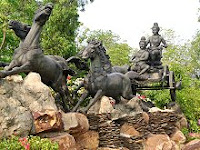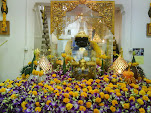此符号在不同佛典中分别出现在佛陀的胸臆、发间、手足或腰间,皆具光明吉祥之义。卍字可能因为与俗体「万」字形相及意思相近,后世遂通称为「万」字。有学者认为卍字与十字同是阿利安族先祖居住在巴克特里及鄂斯河流域时代的重要宗教符号,故两者皆成为日后神圣的标志.
有趣的是:泰国佛教徒向人问候时,皆是双掌合十,称「sawadeeka」,有人认为此词的音义,可能是源自梵语「svastika」,即「卍」字的祝福。
Whatever that is written here is not intended to harm or hurt anybody.Either ways, I bear no responsibilities for any physical or emotional harm to anybody or organisation.



胡

 There are two people you can never repay. What two?
There are two people you can never repay. What two?These ten things nourish the ten things that are desirable, liked, charming and hard to win in the world. What ten? Energy and exertion nourish wealth. Finery and adornment nourish beauty. Doing things at the proper time nourishes health. Friendship with the beautiful nourishes virtue. Restraint of the senses nourishes the holy life. Not quarrelling nourishes friendship. Repetition nourishes great knowledge. Lending an ear and asking questions nourishes wisdom. Study and examination nourishes the teachings. And living rightly nourishes rebirth in the heaven world.
"What do you think about this?" said the Lord. "What is the purpose of a mirror?"
"It is for the purpose of reflection, sir," replied Rahula.
"Even so, an action to be done by body, speech or mind should only be done after careful reflection."
Mahali said to the Lord: "Sir, what is the reason, what is the cause of doing, of committing an evil deed?"
"Greed, hatred, delusion, not paying proper attention and wrongly directed thoughts - these are the reasons, these are the causes of doing, of committing an evil deed."
"Then what, sir, is the reason, what is the cause of doing, of committing a beautiful deed?"
"Generosity, love, wisdom, paying attention and rightly directed thought - these are the reasons, these are the causes of doing, of committing a beautiful deed."
胡
 Ti Tsang P'usa is an extremely popular Bodhisattva among the Chinese and Japanese Buddhists. 'Ti Tsang', meaning 'Earth-Store' is a direct translation of the Bodhisattva's name KSITIGARBHA in Sanskrit. Among the countless Bodhisattvas in the universe, he and three others have firmly captured the hearts of the Mahayanists.
Ti Tsang P'usa is an extremely popular Bodhisattva among the Chinese and Japanese Buddhists. 'Ti Tsang', meaning 'Earth-Store' is a direct translation of the Bodhisattva's name KSITIGARBHA in Sanskrit. Among the countless Bodhisattvas in the universe, he and three others have firmly captured the hearts of the Mahayanists.These three types of thought give vision, seeing and knowledge, they increase wisdom, are associated with harmony, and conduce to Nirvana.
Look not to faults of others nor to their omissions and commissions.
But rather look to your own acts, to what you have done and left undone.
When one looks down on another's faults and is always full of envy, one's defilements continually grow; far is one from their destruction.
If only you would do what you teach others then being yourself controlled, you could control others well. Truly, self-control is difficult. You yourself must watch yourself. You yourself must examine yourself, and so self-guarded and mindful.
胡
胡
The above serve as a general guide, hopefully it will be useful.
Wisdom is purified by virtue, and virtue is purified by wisdom. Where one is, so is the other. The virtuous person has wisdom, and the wise person has virtue. The combination of virtue and wisdom is called the highest thing in the world.
The past should not be followed after,And the future not desired.What is past is dead and gone,And the future is yet to come.
But whoever gains insight into thingsPresently arisen in the here and now,Knowing them, unmoved, unshaken -Let him cultivate that insight.
胡
 Thursday ( Jupiter ): Pharutsabodi (Brihaspati) is the heavenly seer who carries a slate and rides a deer. He corresponds to Jupiter, tutor of the gods. Thursday, his day, is dedicated to teachers.
Thursday ( Jupiter ): Pharutsabodi (Brihaspati) is the heavenly seer who carries a slate and rides a deer. He corresponds to Jupiter, tutor of the gods. Thursday, his day, is dedicated to teachers. Friday ( Venus ): Sukra, the god who presides over Friday, rides a bull. He is considered one of the heavenly seers as well as a tutor of the gods. He is the diety of wealth and fine art.
Friday ( Venus ): Sukra, the god who presides over Friday, rides a bull. He is considered one of the heavenly seers as well as a tutor of the gods. He is the diety of wealth and fine art. Saturday ( Saturn ): Phra Sao (Sani), equivalent to Saturn, with bow and trident in his hands, is considered the god of difficulty. The people who are born under the influence of Saturn are believed to fall easily into grief, despair, and difficulties. He is seated on his vehicle, a tiger.
Saturday ( Saturn ): Phra Sao (Sani), equivalent to Saturn, with bow and trident in his hands, is considered the god of difficulty. The people who are born under the influence of Saturn are believed to fall easily into grief, despair, and difficulties. He is seated on his vehicle, a tiger. Sunday ( Sun ): Phra Athit (also Aditaya or Suriya), the Sun, the god of light, is seated on his chariot of seven skyhorses driven by his rider, Phra Arun.
Sunday ( Sun ): Phra Athit (also Aditaya or Suriya), the Sun, the god of light, is seated on his chariot of seven skyhorses driven by his rider, Phra Arun. Monday ( Moon ): Phra Chan (or Chandra), the Moon, is a male deity who rides a chariot drawn by ten horses. His nature is suave and gentle.
Monday ( Moon ): Phra Chan (or Chandra), the Moon, is a male deity who rides a chariot drawn by ten horses. His nature is suave and gentle. Tuesday ( Mars ): Phra Angkhan (Angaraka) rides a water buffalo. He is Mars, the god of war, hard-work and conflict.
Tuesday ( Mars ): Phra Angkhan (Angaraka) rides a water buffalo. He is Mars, the god of war, hard-work and conflict. Wednesday ( Mercury ): Buddha is an Indian equivalent of Mercury and Woden. He rides an elephant. He is the deity of wisdom, communication and books.
Wednesday ( Mercury ): Buddha is an Indian equivalent of Mercury and Woden. He rides an elephant. He is the deity of wisdom, communication and books. 曼谷市長阿披叻30日主持迎請神聖佛像到皇家田廣場供奉儀式,供廣大民眾在新年期間前往膜拜祈福。阿披叻強調,今晚在中央世界廣場和皇家田廣場將舉辦的新年倒數計時活動,安全工作已全面就緒。 阿披叻市長昨天和曼谷市政府官員一同主持迎請神聖佛像到皇家田廣場中央供奉儀式,以讓廣大佛教善信前來膜拜祈福。阿披叻市長為佛像安座舉行點燭,意味著曼谷市慶祝新年活動正式拉開序幕。佛像將供奉在皇家田廣場直到2008年1月1日。每天早上6時45分將為181名僧人進行齋僧。而皇家田廣場舉行的新年倒計時慶祝活動,將以彩燈和音樂為主,並突出曼谷王朝的文化特色。
曼谷市長阿披叻30日主持迎請神聖佛像到皇家田廣場供奉儀式,供廣大民眾在新年期間前往膜拜祈福。阿披叻強調,今晚在中央世界廣場和皇家田廣場將舉辦的新年倒數計時活動,安全工作已全面就緒。 阿披叻市長昨天和曼谷市政府官員一同主持迎請神聖佛像到皇家田廣場中央供奉儀式,以讓廣大佛教善信前來膜拜祈福。阿披叻市長為佛像安座舉行點燭,意味著曼谷市慶祝新年活動正式拉開序幕。佛像將供奉在皇家田廣場直到2008年1月1日。每天早上6時45分將為181名僧人進行齋僧。而皇家田廣場舉行的新年倒計時慶祝活動,將以彩燈和音樂為主,並突出曼谷王朝的文化特色。 Her Royal Highness Princess Galyani Vadhana passed away at Siriraj Hospital, announced the Royal Household Bureau. She was 84.The Princess' condition worsened on Tuesday night and she passed away at 2.54 am on Wednesday January 3, 2007.
Her Royal Highness Princess Galyani Vadhana passed away at Siriraj Hospital, announced the Royal Household Bureau. She was 84.The Princess' condition worsened on Tuesday night and she passed away at 2.54 am on Wednesday January 3, 2007. 泰国甘拉雅妮瓦她娜皇姐殿下昨天(2日)凌晨2时54分,在曼谷驾薨,享年84岁。
泰国甘拉雅妮瓦她娜皇姐殿下昨天(2日)凌晨2时54分,在曼谷驾薨,享年84岁。